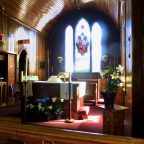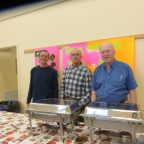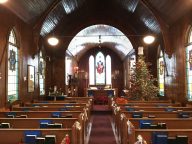Witnesses, December 17, 2014
Every Advent, one of the main characters who shows up is John the Baptist. (Of course, I prefer to think of him as John the Anglican rather than John the Baptist! But that’s another story …)
Last week, we read Mark’s story of John the Baptizer. Mark painted him in all his glory as the wild man of the desert, baptizing everyone who came, preaching about their need to repent. In Mark, John is a charismatic figure, who drew the crowds to him: “People from the whole Judean countryside and all the people of Jerusalem were going out to him.” He was a fiery preacher and powerful prophet who has a ministry in his own right.
The 4th Gospel portrays John quite differently. It’s quite remarkable how different that portrait is. He’s not even called the Baptist. “There was a man sent from God, whose name was John.”
We go on to read in the 4th gospel that John’s main role is to be a witness: “He came as a witness to testify to the light … he himself was not the light; he came to testify to the light.” If all we had was this gospel, we might well call him John the Witness.
The man named John is out at the river Jordan. The religious authorities go out there to challenge him. They are the guardians of orthodoxy. They are charged to keep the public order, and John is a disruptive force. “Who are you? What are you doing? Who told you you could do it? Who gave you the right?”
John responds quite clearly, “I am not the Messiah. I am not the prophet. I am not the one who is coming. I’m here for only one purpose—a voice crying out to prepare the way for the one coming after me.”
This is John’s role in the 4th Gospel. He testifies. He is a witness. Giving witness is one of the central themes of the 4th Gospel. The church is sent out into the world to be a witness. We who follow Jesus are called to be witnesses.
We are called to witness to a God who gives us life in all its abundance. We are called to witness to the light.
This is part of our preparation in Advent. That’s why we light candles each Sunday of Advent. We begin with one flickering candle. As the season progresses, we add a second candle … then a third … and finally next week a fourth.
Then, at the culmination of Advent, we enter the celebration of Christmas, we celebrate the birth of our Saviour, and we light the Christ candle. The whole world is ablaze with the Light of Christ. At the end of each service on Christmas Eve, we light our own candles from the Christ Candle, and we are charged to go out into the world, bearing the light which we have been given.
Our preparation during Advent is so that we might become more clearly people of the light. The light is growing in us. Each week, we go into the world and point to the signs of God’s light wherever we see them in our world. Like John, we become witnesses, seeing God in every act of kindness and grace and love.
I think this “learning to see” is a large part of what it means to be a follower of Jesus. Richard Beck reminds us that the kingdom of God is more about perception than it is about learning to be moral. In other words, being a follower of Jesus is about learning to see God at work in the world. It is not so much about becoming good people, or more moral people. Being Christian is about learning to see. We learn to see other people through the eyes of God. We learn to see the world through the eyes of God. We learn to see our lives through the eyes of God.
Being a witness is about learning to see, and then telling others what we have seen. It’s about discerning where God is present, where God is at work in our lives and in our world. It’s about learning to see deeply into the heart of reality and knowing that God is there.
We are people of God. We are people of the light. We are witnesses of what God has done in our own lives, and we want to share that story with others.
John points to the one who is coming and helps us learn to see. John points to the light wherever the light shines in the world.
The whole Bible is like that. It is filled with people who help us learn to see.
Listen to Isaiah’s witness: “The Spirit of the Lord God is upon me … to bring good news to those who are oppressed, to bind up the broken–hearted, to proclaim freedom to the captives, to comfort all who mourn, and to proclaim the year of the Lord’s favour.”
In a world where we hear enough bad news, Isaiah invites us to see those places in our lives and in our world where God’s goodness and grace are being born. Isaiah invites us to proclaim freedom and grace, comfort and hope. We are called to witness to God’s love in action all around us. See … really see … what God is doing.
Mary does the same thing. “My soul magnifies the Lord, who has done great things for me. God has lifted up the lowly, filled the hungry, and sent the rich away empty.” Mary invites us to see how God’s reign is overthrowing the rule of the powers that be in our world. Mary sings of a world made new, a world of justice and hope and well–being for all people. See … really see … what happens when we live within the reign of God.
So this morning, along with John, Isaiah and Mary, I also invite you to see:
- see God working towards a home for all as people give generously to support the homelessness outreach and prevention in our Advent project;
- see God at work to proclaim good news as people in Cranbrook support the ministry of Christ Church, First Baptist, Cranbrook Alliance, and all the other churches;
- see God at work as people go caroling to bring a little bit of cheer to the lives of people in hospital and care homes;
- see God at work in the smiles and warm wishes of people on the streets and in the malls;
- see God at work in the #MeToo movement as women speak out powerfully against those powerful men who abused and harassed them in the workplace;
- see God at work at the Food Bank as people make donations to feed the hungry;
- see God at work in the jingling bells of volunteers at the Salvation Army kettles;
- see God at work in anti–bullying campaigns, and whenever members of the LGBTQ2 community are welcomed and embraced;
- see God at work as we work together with aboriginal brothers and sisters to foster truth and work towards being reconciled;
- see God at work as people visit the lonely, bringing a few cookies and taking the time to let them know they are loved.
See. Really see. See God at work.
Then testify. Tell the story. Share what God has done in your life. Witness to what you see God doing in our world.
God’s life is being born in our world. God’s light shines in the darkness, no matter how faintly.
And when we see God at work, when we become witnesses of all that God is doing, we are preparing God’s way. We begin to act as midwives for the birth of hope in our world. We embrace and share the true life of God.
And then, like Mary, like Isaiah, like John, we begin to sing of the transformation of the world. When God is present, life is made whole and good, not just for some—but for everyone. When we live out God’s gospel purposes, there will no longer be those who have and those who have not. When we work with God for the healing of the world, there will no longer be the strong bullying the weak. When we honour God in all that we do, when we see and testify, when we prepare, the vulnerable will no longer be harassed and traumatized by the powerful.
All will be embraced. All will be made whole. All will be filled with life. All will receive life in all its abundance.
Thanks be to God.
Rev. Dr. Yme Woensdregt
December 17, 2017 (3rd Sunday of Advent)
John 1: 6–8, 19–28
Isaiah 61: 1–4, 8–11
1 Thessalonians 5: 16–24







